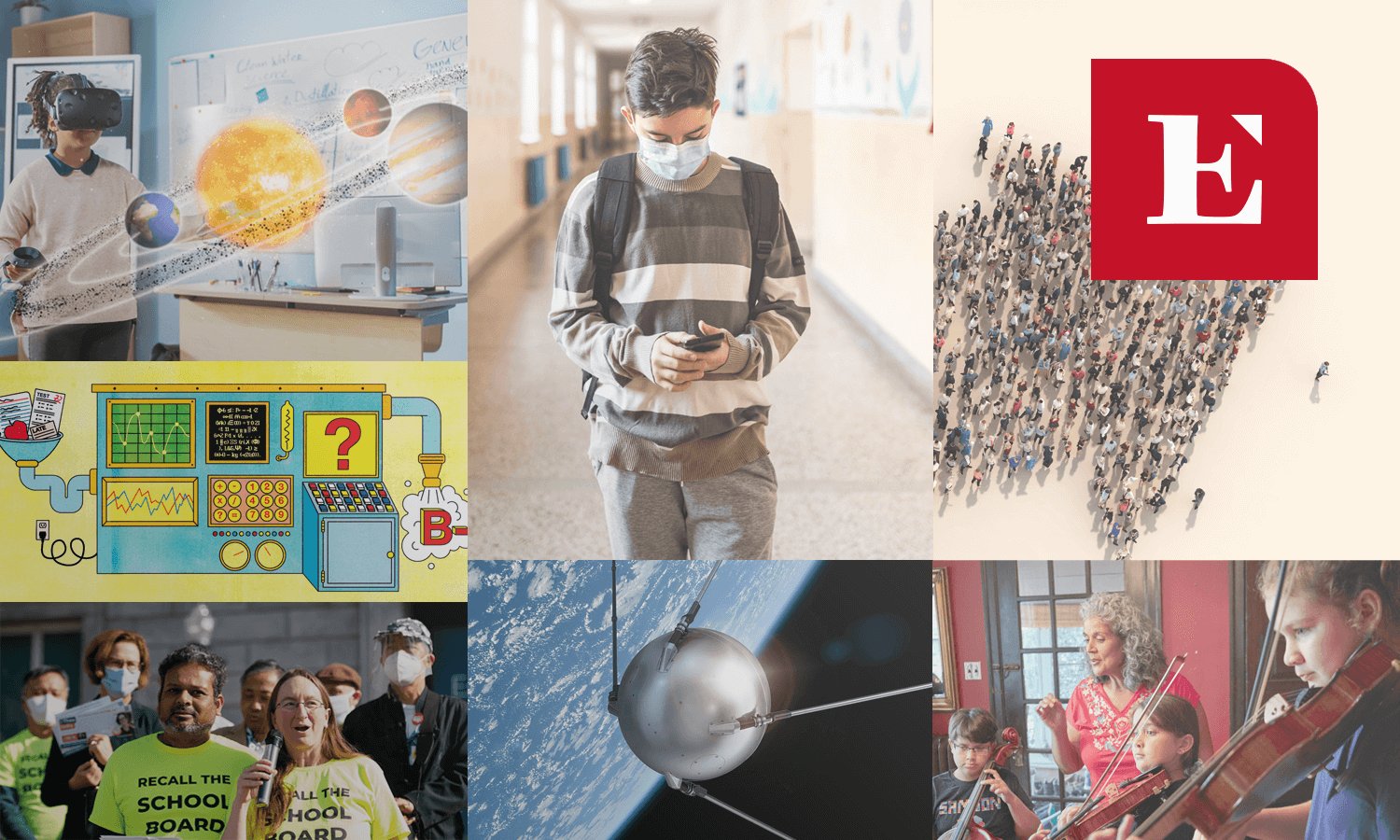
Nearly all U.S. public and private schools are closed because of the novel coronavirus, and at least 55 million of the nation’s 57 million elementary and secondary school students are out of school. To date most schools have been closed about three weeks, but seven states have announced that schools will not reopen this academic year, four have closed schools “until further notice,” and another nine states plan to keep schools closed at least into May. The remainder still have nominal plans to reopen in April, but it seems likely that most if not all of those closures will be extended further.
What is the likely impact of long school closures on children’s short-term learning and long-term success? Not good. While the current nationwide closures are unprecedented, history offers several examples of local school closures lasting months or even years. Teacher strikes closed New York City public schools for more than two months in 1968 and closed French Belgian schools for more than two months in 1990. Massive resistance to desegregation closed public schools in Norfolk, Charlottesville, and Warren County, Virginia for five months in 1958-59, and deprived black children of schooling for four years, from 1959 to 1963, in Prince Edward County, Virginia. Severe natural disasters—most notably hurricanes, but also earthquakes, tsunamis, even plagues of locusts—have closed schools or kept children home for periods of months or even years. Heavy snowfall sometimes closes schools as well, but snow closures are typically short and usually made up by adding extra days to the end of spring semester.
The impacts of closures on children’s success are typically negative. When students returned to New York City schools after the two-month strike of 1968, their test scores were about two months lower, on average, than children’s scores the previous year. French-speaking Belgian students affected by the 1990 strike were more likely to repeat a grade and did not advance as far in higher education as similar Flemish-speaking students whose teachers did not strike. Test scores fell sharply among New Orleans-area children whose schools closed because of Hurricane Katrina, although some of these children, particularly from struggling schools in the city, made up the losses when they transferred to better schools, mainly in Texas.
Ed tech will help, but its impact will be uneven
Although the coronavirus closure is challenging, students will probably learn more, on average, than students did during closures past. Today’s students have a couple of advantages over previous generations. One is technology. Today teachers can communicate and collect lessons and assignments using email, websites, cloud storage, and videoconferencing software. Students can form study groups using the same technologies. There is a wide variety of educational software and games, all of which are getting what amounts to a once-in-a-generation stress test.
But ed tech doesn’t buffer all children equally. According to a 2017 census survey, about one child in seven lacks home internet access, and the fraction was twice as high in families with low incomes and less educated parents. The School District of Philadelphia, laboring under the impression—likely mistaken—that half its children lack internet access, has refused to provide any students with online instruction until the equity issue is resolved. The district is spending $11 million—nearly half contributed by private donors—to give 50,000 laptop computers to students in traditional public schools. Even so, teachers will not start teaching online until May 4—seven weeks after school closed.
Even if all families have access, the impact of technology will still be uneven. Some schools and districts will make better use of technology than others, and few will use technology as well as they could if they had more time to plan. Few modern ed tech products, even wildly popular ones like Khan Academy, have been evaluated rigorously, and there was hardly time to conduct a systematic review of evidence before schools shut down.
Most ed tech products were meant to supplement school, not to replace it outright, and some functions of school are hard to replace, especially when it comes to younger children and softer skills. A third grader learning arithmetic facts may do pretty well with adaptive software drills, and a self-starting high school senior may be able to prepare for AP exams using emailed assignments and practice tests. But for a kindergartener who needs to learn not to cut line, yell, or hit classmates, technology is not much of a solution. Reluctant first grade readers who’ve never had more than 30 minutes of homework may cause trouble when they see their first emailed assignment. And children with serious learning disabilities may be seriously out of luck.
Parents are unequal, too
The other buffer that children have is their parents. Because so many parents are working remotely or out of work, children have more access to their parents today than they’ve had during previous closures. When teachers struck a generation ago, some married mothers were able to stay home. Today fathers are home as well. And children have fewer siblings today to compete for their parents’ attention. At least on average.
Parents, though, are even more unequal than technology. An only child with two college-educated parents may get a lot of help and enrichment—particularly if those parents are financially secure, have flexible work arrangements, and aren’t too freaked out by news and social media. But consider a single parent with three children and a high-school education. Her children will have to compete for her attention, and when they get it, it’s less likely she can help them with homework and technology. If the parent has just lost her job, fears infection, and has less than a month of expenses in the bank, helping her second grader with schoolwork may seem like a low priority. As one mother of four told the Associated Press, “My worry is survival, not conjugating verbs.”
We’ve known since the 1966 Coleman Report that families are much more unequal than schools. We’re about to see what happens when we turn up the volume on families and turn it down on schools.
Is summer learning a good analogy?
Because I do research on summer learning, a number of people have asked whether summer learning research provides much insight into what’s going to happen while schools are closed. I thought the analogy was plausible at first, but as I’ve thought about it more, some of the similarities break down.
Older summer learning research suggested that the reading and math gaps between advantaged and disadvantaged children grew dramatically during summer, while growing slowly if at all during the school year. That fit nicely with the idea that families are more unequal than schools. As I wrote last summer, though, recent findings on summer learning have failed to replicate the old results. In some studies, gaps barely change during summer. In other studies, gaps grow during summer, but no faster than they grow during school.
If families are more unequal than schools, why doesn’t research consistently show that reading and math gaps grow fastest when school is out for summer? One possible reason is that upper-class families aren’t necessarily trying to build their children’s reading and math skills during summer. Families of all social classes tend to view summer as a vacation—a time when kids can be kids, watch television, play sports, see friends, and spend time outside. While there’s not much academic research on how children spend their summers, a study of California children in 1989-90 found that, though poor children watched a lot more television during summer, both upper and lower class children changed their average reading time very little. And no one thought to ask how much time they spent doing math.
The current crisis is different. It’s not a vacation, as I keep telling my 10-year-old daughter, and there’s still half a semester’s worth of curriculum to learn. If families differ in their ability to support their children’s learning, especially during an economic crisis, this is when we’re going to see it.
Predictions
I’ve got several predictions for when school resumes in the fall—if it does resume in the fall. Almost all children will be behind where they would have been had school stayed in session. Score gaps between the children of more and less educated parents will have grown. And lots more kids than usual will need to repeat a grade, especially in kindergarten.
The challenge will be that schools won’t know which kids need retention or remediation, because schools won’t have any spring tests to go on, and the teachers won’t have seen the students in person for six months. Perhaps some of the money saved from canceling the spring tests can be reallocated to diagnostic testing in the fall. Districts that already routinely conduct such testing may be best positioned of all to measure precisely what has been lost from the pandemic—at least in the academic sense.
Paul von Hippel is an Associate Professor at the LBJ School of Public Affairs, University of Texas, Austin, where he teaches education policy and research methods. He thanks his employer for finding emergency childcare that let him write this article and teach his classes.
Read more from Education Next on coronavirus and Covid-19.
For more, please see “The Top 20 Education Next Articles of 2023.”





